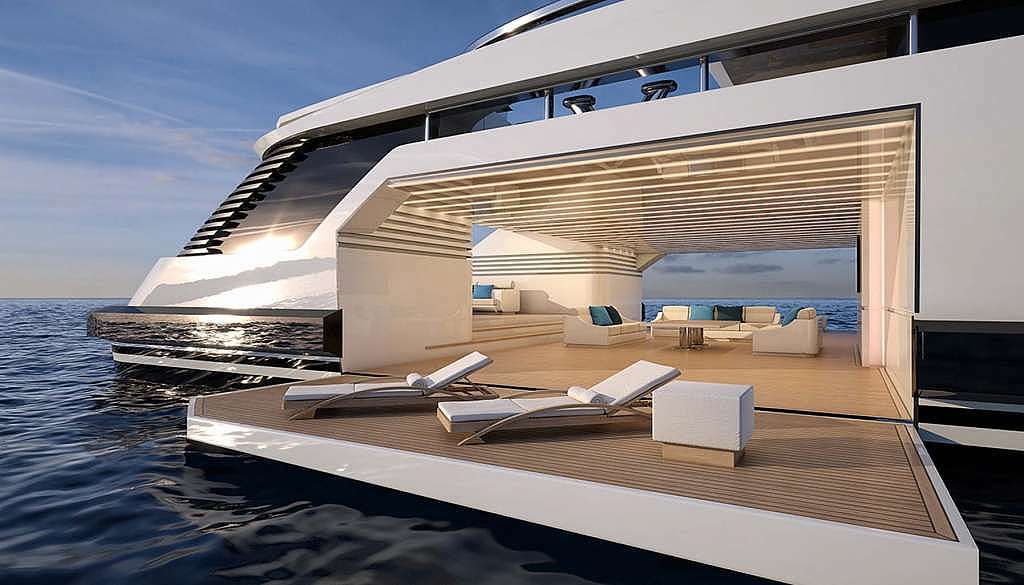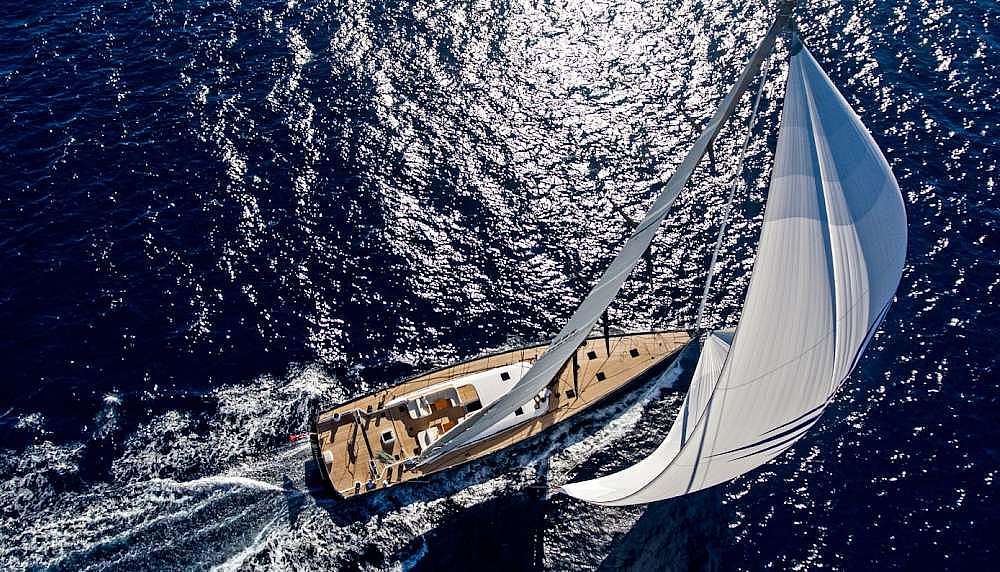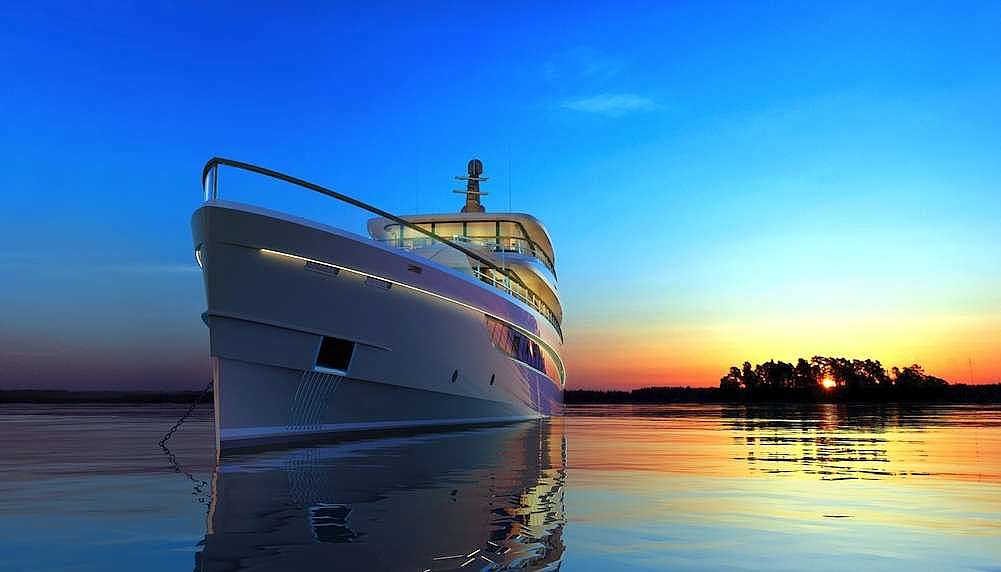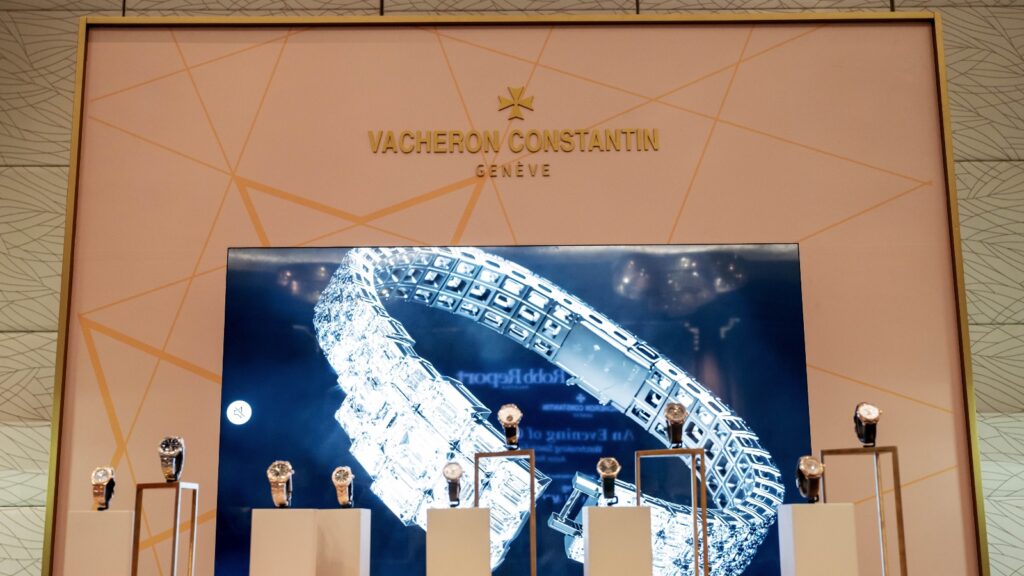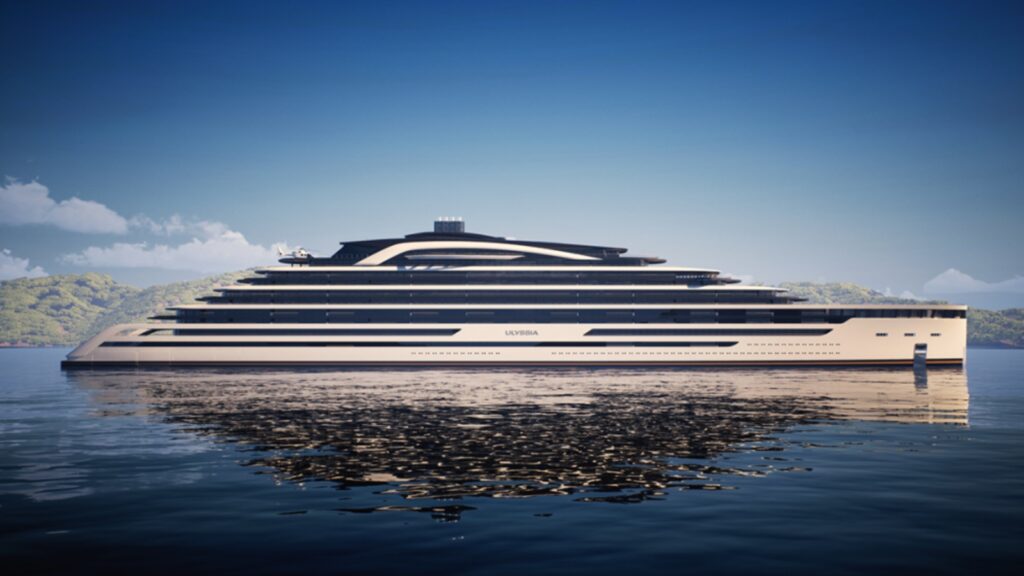Pier-ing into the future
The Monaco Yacht Show, which included four days of sunshine and several Prince Albert II sightings, arguably carried the most positive vibe of last five years. More than 34,000 attendees walked the docks at Monte Carlo’s Port of Hercules, most venturing onboard the 125 superyachts and 35 tenders on display in the marina.
Some took tenders to the offshore behemoths like the Kleven-built 107m Ulysses, which can accommodate 60 guests across seven decks. Others just enjoyed a ride around the marina on new tenders like the Silver Arrows Arrow 460-Granturismo or Apex 60, relishing being surrounded by the towering superyacht hulls. The 47 launches at the show this year were, as usual, a wide mix of gigayachts, explorer vessels, and sailing yachts.
Pocket superyachts like Dynamiq’s Jetsetter showed what a new shipyard can do with creative design, while refits like Lürssen’s 72.5m Coral Ocean demonstrated that classic designs can still look contemporary after two decades. Perini Navi’s 70m Sybaris, with its stunning interior, illustrated why the Italian yard remains royalty in the superyacht sailboat niche.
Visitors to the Monaco show also saw a boatload of new concepts that offer a glimpse into yachting’s future. Some like Feadship’s Choice bordered on sci-fi fantasy, while others like Mondomarine’s Arte could go under build tomorrow. Whatever the fancy, there was a yacht for every taste at Monaco. Here are 12 of the show’s finest, both new yachts and concepts.
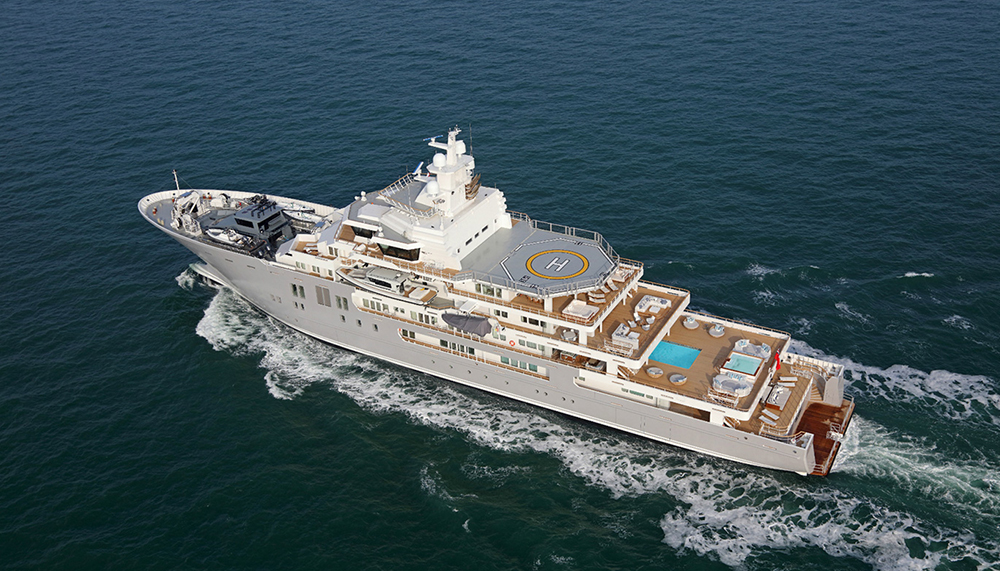 Kleven Ulysses
Kleven Ulysses
One of the stars in Monaco this year was not technically at the show, but anchored in the Mediterranean outside Monte Carlo’s Port of Hercules. Ulysses, the 107m behemoth from the Kleven shipyard in Norway, had been delivered to its owner in spring. The world’s fourth-largest expedition yacht has an imposing, almost military-looking exterior, with seven decks and a C Ice Class steel hull.
Despite the rugged exterior, Ulysses has one of the more elegant interiors among the gigayacht class. H2 Yacht Design worked hard to create an open and contemporary interior that rivalled any other yacht displayed in Monaco. H2 made full use of the 18m beam, filling the large saloons and dining room, as well as the 15 staterooms, with light-coloured furniture and other elegant decor, including many pieces of modern sculpture. Curved walls and full-height windows also added light and space to the overall design. The yacht carries 30 passengers, along with accommodations for 40 crew. The owners have their own deck. While Ulysses spent the summer cruising the Western Mediterranean, it has a range of 13,600km for long-distance trips.
Other noteworthy features include a certified helicopter landing pad and hangar. A 21m catamaran tender, capable of reaching 50 knots, has special cranes that lift it onto the foredeck. Ulysses also has a small navy of other tenders and water toys. Comfort spaces include a swimming pool, a 12-person Jacuzzi, and a cinema.
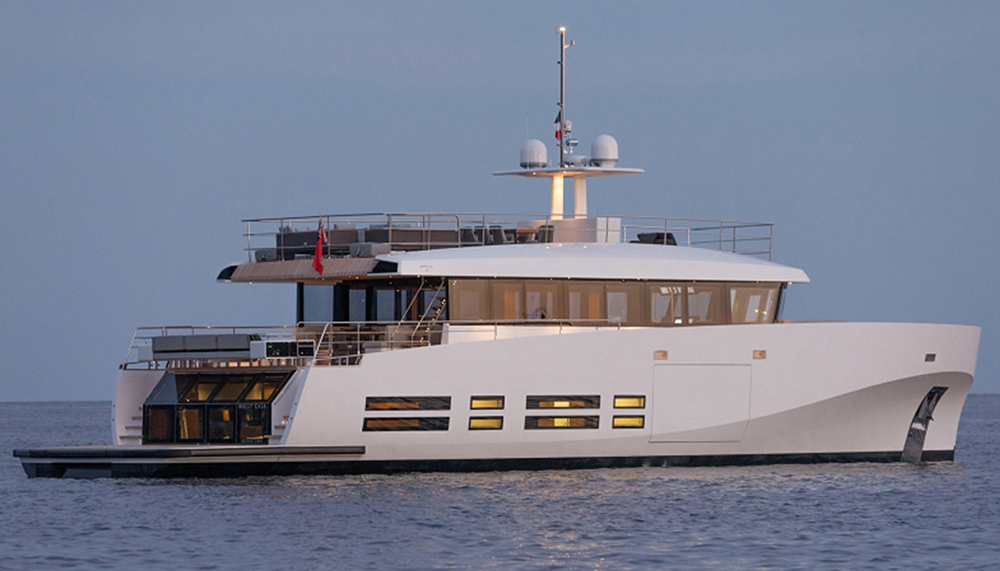 Wally Casa
Wally Casa
The 27m Wally Casa was designed by Wally and Luca Bassani Design to optimise every inch of space, inside and out. The melding of the interior and exterior is achieved through a minimalist design, using 360 degrees of saloon windows, patios in three outdoor areas, and an open floor plan. Wally Casa feels more like a villa than a yacht. The walnut joinery carries a sense of warmth throughout the interior, from the saloon to the aft owner’s suite on the deck below. That suite offers the ultimate ocean view from its own terrace, accessed by sliding glass doors. The double cabin and twin cabin with a Pullman berth allow the boat to accommodate seven in comfort.
The futuristic-looking yacht is the fourth in the WallyAce series, with signature dimples in the bow areas. Wally Casa’s exterior is also as spacious as the interior, with a large aft cockpit for socializing. That party, or a second one, can also move to the flybridge, which has rear loungers, a centre bar, and a forward sunbed. On the foredeck is a custom Jacuzzi and seating for more intimate gatherings. After cruising the Mediterranean last summer, Wally Casa’s American owner plans to keep her at a home in Baja California, Mexico.
 Apex 60
Apex 60
One of the most compelling small-boat launches at Monaco was the Apex 60, a joint project of Italian naval architects and German designers. Apex calls the 60 a ‘tender’ but that’s probably not an apt description for this new yacht. It certainly looks good on the deck of any mothership, but the sun loungers on the aft and foredecks, the high-tech helm area beneath the large, curved hardtop, and the full cabin, make it far more than transportation for owners and guests.
The 60 is a boat that could explore all day in places where its mothership simply can’t go. Triple Volvo IPS powerplants give the 60 an impressive top end of 40 knots, and look in sync with the slender shape of the bow. Beyond better fuel efficiency, the Volvo system reduces vibration across the boat, making day cruising or overnighting a more pleasant experience. Apex also paid attention to small details that make life onboard more comfortable, including an electric gangway, a plug-in shower for the swim platform, and a multi-function kitchenette on the exterior. The touchscreen helm also has solar/battery backup power in case the engines go out. Apex can customise the 60 for owners who want a specific interior layout but the standard version at Monaco seemed highly functional.
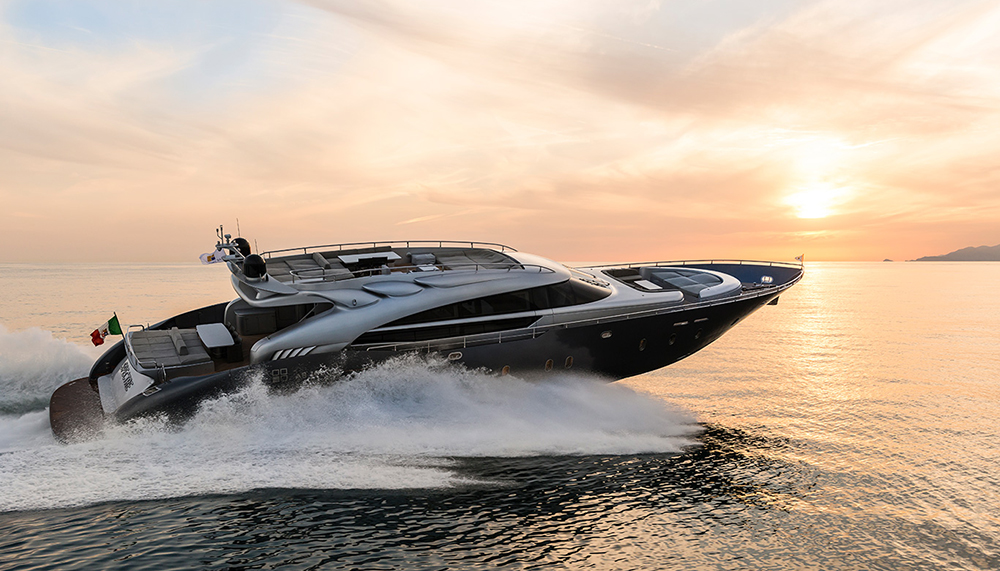 AB Yachts’ Spectre
AB Yachts’ Spectre
Any 30m yacht that can top 50 knots has to be very carefully built, using the most advanced composites, carbon fibre, and lightweight core materials chosen to save weight. At this size range, with the goal being to keep weight down and speed up, every ounce is critical.
AB Yachts’ new 100, Spectre, accomplishes that very difficult mission as a lightweight, 52-knot speed-demon superyacht. Its spacious interior, flybridge, and beach club also deliver the same levels of luxury found on any other 30m, whether it’s a performance yacht or not. AB’s designers combined wraparound windows, light-coloured woodwork, and loose furniture to give the saloon an airy, open feeling, with loungers aft, dining table centre, and the glass-cockpit helm forward. The minimalist feel of the saloon, in fact, is more akin to a contemporary penthouse than a traditional yacht interior. That same sense of open space dominates in the full-beam master suite belowdecks, as well as in the three other staterooms. While AB didn’t skimp on luxury, its primary goal was to keep Spectre as light as possible. For that, it used specialised materials. The joinery, for instance, has cored material under the wood veneer to maintain the 100’s top fighting weight.
Outside, AB designed social areas into Spectre’s bow, with facing loungers and table, and in the aft cockpit is an al-fresco dining table. On the flybridge are large sunbeds, table and loungers, and a cool, fold-down second helm. The biggest surprise is the beach club at the transom, created by joining the teak swim platform with the teak-covered garage. When the tender is out, the owners can use the garage space as a hideaway connected to the platform. Of course, Spectre’s heart is her propulsion system – three 1,900-hp MAN engines mated to MJP waterjets, which deliver the 52-knot top end. That is greased lightning compared to other yachts in her class.
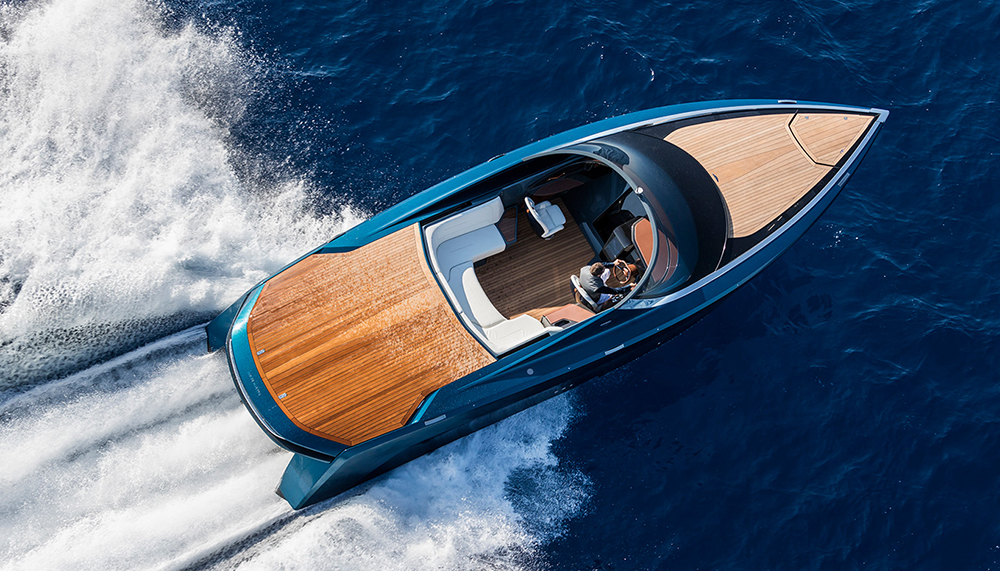 Aston Martin AM37
Aston Martin AM37
One of the most eagerly anticipated launches in Monaco was the new Aston Martin AM37. Built in the U.K. from a collaboration between Quintessence Yachts and some of Aston Martin’s design team, the AM37 lived up to the pre-show hype. With its dark green hull, sprawling teak decks, and tall wraparound windshield, the AM37 looked like the ultimate Bond boat at the Monaco docks.
The beautiful simplicity of the exterior was the brainchild of the Aston Martin designers who created iconic cars like the One-77, Vulcan, and DB11. Mulder Design in the Netherlands made sure the seaworthy, stepped hull lived up to the Aston Martin name for tight cornering and steady running.
Away from the dock, the AM37 powered through the chop outside the Monaco seawalls with an authority that many speedboats never command in even small seas. Quintessence opted to use standard MerCruiser sterndrives as power, rather than specialised inboards, so owners can service them without problems. The choice of power includes two 370 hp MerCruiser (gas or diesel engines) or two 520 hp MerCruisers. The yacht at Monaco had the 520 hp racing engines. It delivered a solid but hold-onto-your-hat ride, topping 50 knots.
The AM37’s cockpit is as meticulously crafted as any Aston Martin car, with leather handrails and side pouches (with impeccable stitching), a leather helm console around the touchscreen display, and even leather adjoining the throttles. Other minute details like the honeycomb cover over the rear engine exhausts also distinguish the boat. The interior includes a bed for two, a galley, and a head.
Like the cockpit, interior fit and finish is flawless. Perhaps the coolest part of the AM37 were several Bond-like features, such as an electro-hydraulic bimini top that is positioned under the engine hatch until it’s needed. With the push of a button the aft deck tilts up and the bimini covers the cockpit. The aft deck also turns into a swim platform extending over the transom for easy access to the sea.
 Mondomarine M70 Arte
Mondomarine M70 Arte
Mondomarine’s M70 Arte concept, designed in collaboration with Stefano Inglese at Giorgio Vafiadis & Associates, was one of the more elegant concepts unveiled at the Monaco show. The 70m yacht, if it ever makes it into production, would be the largest the Italian yard has ever built. Inglese, recipient of the Young Designer of the Year award in 2013, said at a press conference that Arte was “inspired by the beauty, creativity, and simplicity of modern art.”
Reflecting his words, Inglese gave the yacht a long, slender, and minimalist exterior. But he also paid particular attention to the transom to enhance the quality of life onboard. Arte’s massive beach club features a long, fold-down transom that becomes a long swim platform and panels that open on both sides, providing 180 degrees of access to the sea. Arte also has a spa and gym connected to the beach club. For guests who want to move elsewhere, the boat has a sundeck Jacuzzi and a foredeck swimming pool. Inglese’s use of a glass shell over the wheelhouse, situated on the sundeck, gives the area an almost atrium-like look. “The gray mullions on the sides of the bridge give you the impression that the boat is one deck lower than it is in reality,” he said. Arte will have accommodations for 12 guests across seven staterooms. Crew quarters are designed for 24 staff.
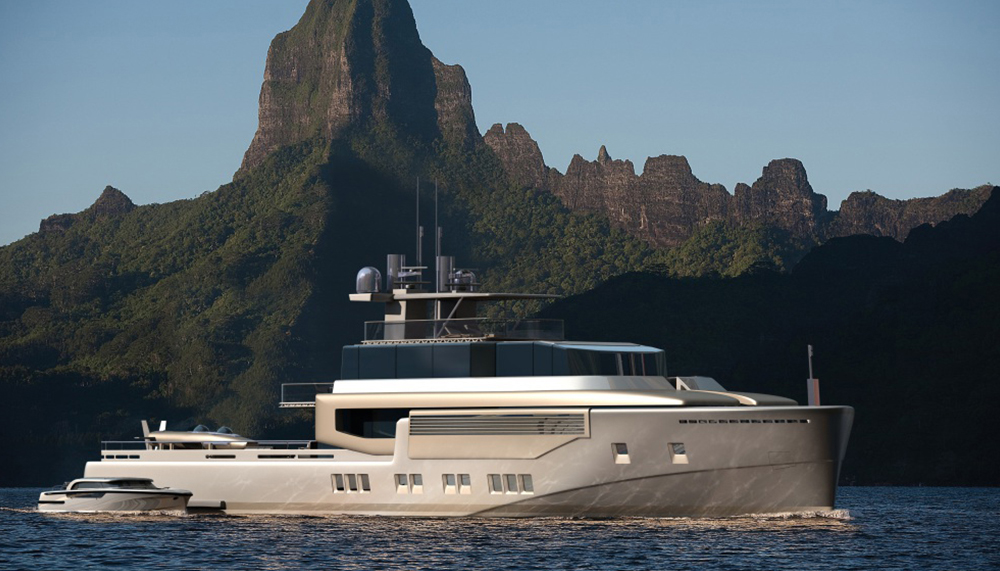 Rossinavi Argo
Rossinavi Argo
Italian shipyard Rossinavi, known for its bespoke superyachts, announced that it had partnered with London designer Ken Freivokh on the Argo project. The 48m expedition yacht had its origins with a design Freivokh was working on for the late Tom Perkins, owner of the unique Maltese Falcon sailing superyacht. Perkins, not one for compromises or convention, wanted an expedition yacht that had more than a tough-guy look, but was in reality a paper tiger. With Argo, Freivokh has designed an explorer yacht that is as intrepid as it looks, with an ice-class hull, transpacific range, and deck spaces for limousine and service tenders, submarine, and amphibious vehicle. When the tenders are in the water, the open deck serves as a helipad.
“Argo was designed as a proper exploration yacht, with purposeful styling targeted at functionality and operational considerations,” Freivokh said at the Monaco press conference. The luxurious side of Argo is up front, with a full-beam owner’s suite on its own deck that includes a study, his-and-her bathrooms, and a private terrace. Guests are well accommodated in the staterooms below. In keeping with the explorer theme, Argo even has a crow’s nest on top for stunning views of the water.
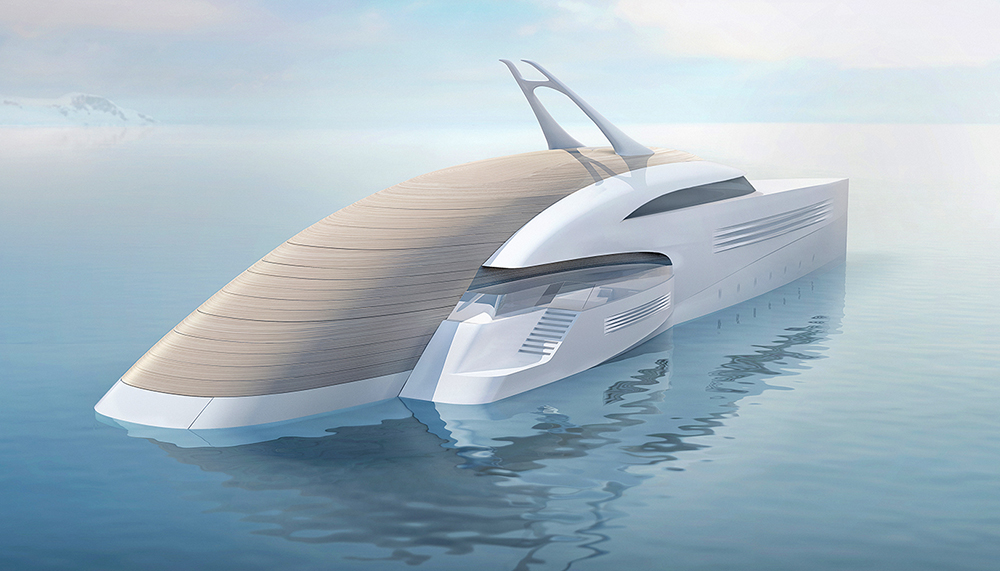 Feadship Choice
Feadship Choice
At Monaco, a Feadship representative said that its Future Concept this year was its most “audacious blueprint for inspiration to date.” That’s almost an understatement. Feadship’s Future Concept was launched in 2006 to inspire yacht owners to think differently about the possibilities of yacht design. This year’s Choice concept, however, is more like an episode of a sci-fi series. Among the futuristic features of the 71m is a flying passenger drone, detachable beach club at the transom, motion-compensated swimming pool, and perhaps most daring of all, tenders that carry the mothership’s primary engines.
Choice’s means of propulsion, in fact, are located in the two 80-foot tenders on either side of the yacht. Choice will also have its own electric propulsion package as a backup, which will be charged by the tender engines when they’re docked. “This arrangement allows for the type of slow steaming operation adopted by large cargo vessels,” notes Ruud Bakker, Feadship’s senior designer. “In addition to silent anchoring, the mothership will be whisper-quiet when steaming along at cruising speeds.” Bakker added that Choice will also be 29 percent more fuel efficient than existing Feadships of the same size.
The super-large tenders, appropriately named Freedom Won and Freedom Too will have a top speed of 25 knots. “They also offer exceptional comfort, including two double suites, a single cabin, and a lounge,” says senior designer Tanno Weeda. They will also be able to go where the mothership cannot. The flying passenger drone and the amphibious beach house that detaches are two other ways to leave the mothership behind.
Choice’s designers have even envisioned the Feadship Independent Control System (FICS) to relieve the captain and crew of having to run the yacht. FICS uses sensor technology and real-time online data like wave radar, weather forecasts, and traffic information to gather information about surrounding conditions. Intelligent control processes determine exactly how the yacht will respond. No longer will the captain have to determine the best strategies for finding the most suitable route, or even figuring out where to anchor. FICS does it without any human interference.
Seasoned yachters may chuckle at Choice’s sci-fi stretches of reality, but some of Feadship’s previous future concepts have greatly influenced modern superyacht design in the last 10 years. They include extensive use of exterior glass, lower fuel consumption, and hybrid propulsion systems. Why not a detachable beach club?
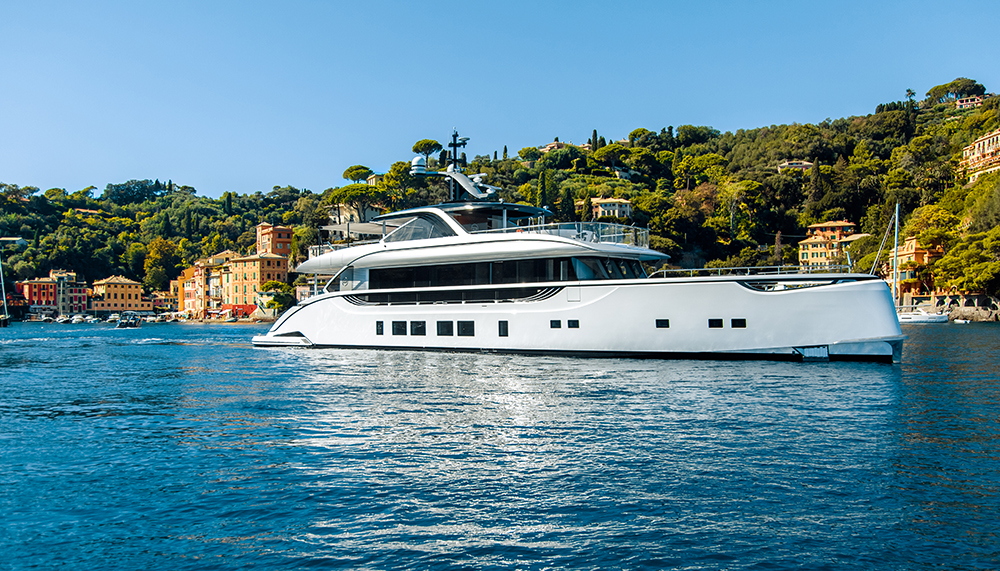 Dynamiq Jetsetter
Dynamiq Jetsetter
Dynamiq’s first-ever launch, Jetsetter, made quite a splash at the Monaco show. The D4 model, with its eagle’s head profile, was designed to incorporate the feel and features of a larger superyacht into its compact, 39m hull. The Gran Turismo Transatlantic (GTT) design by Dutch naval architects Azure Marine incorporated the best of all worlds into its fast displacement hull—21-knot top end, draft of only 1.75m, and a range of 4,800km at 10 knots.
On a tour of Jetsetter, I was most impressed with the interior by Bannenberg & Rowell. The London designers used loose couches, chairs, and other accessories in the saloon and staterooms, rather than building in fixed furniture, so it had the feel of a contemporary waterfront pied-à-terre, rather than the more formal look of many yachts. The saloon’s large picture windows, gave the area a much larger feel than most yachts in its class. It connects to a dining room that also seems voluminous, without being stodgy. The same sense of space occurs in the full-beam master suite, located aft on the lower deck, as well as the three other staterooms forward.
Bannenberg & Rowell maintained the elegant, informal feel across Jetsetter by using light colours and a hexagonal motif that showed up everywhere – on walls, in carpet patterns, and even on tables on the flybridge. Jetsetter’s flybridge, by the way, makes a wonderful gathering point, with its Jacuzzi, dining table, and many loungers. It also boasts an outdoor theatre. Jetsetter is certainly a strong start for Monaco-based Dynamiq, promising to be the first of many superyachts incorporating its forward thinking in both the structural engineering and interior design.
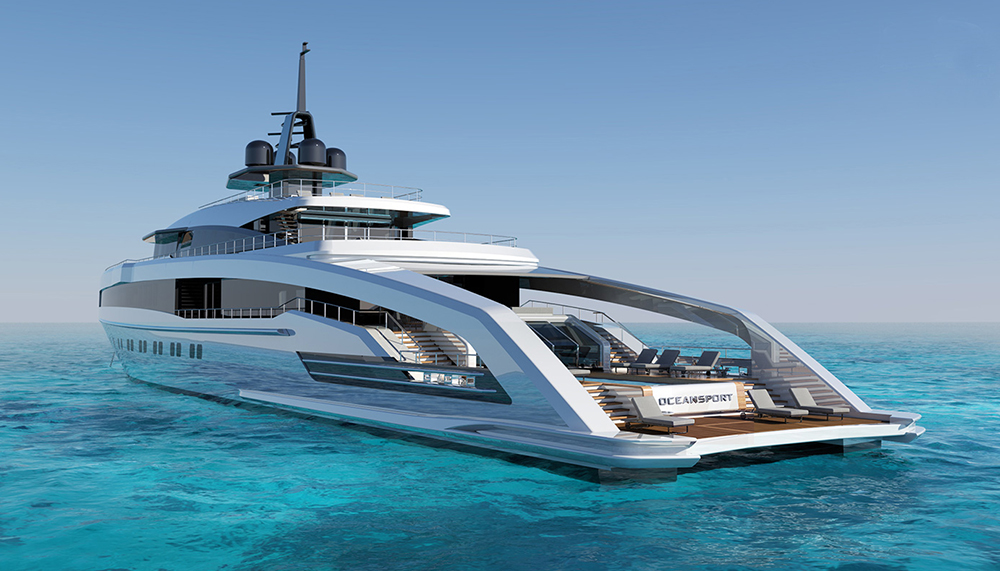 CRN Oceansport 75
CRN Oceansport 75
CRN, the custom superyacht division of Ferretti, didn’t have any new launches at the Monaco show this year. But a number of the six superyacht concepts it unveiled at a press conference will no doubt become reality over the next five years. New designs from Zuccon International Project, Nuvolari & Lenard, Omega Architects, and Francesco Paszkowski Design, who have all designed CRN hulls in the past, were made public at the show.
One of the more adventurous designs in the group was the Oceansport 75 by Omega. The 75m yacht, with its beam of 16.7m, incorporates a wild-looking stern area that is mostly open to the sea. Side arches, a centrepiece swimming pool, and the long swim platform could well make up the superyacht world’s ultimate beach club. The Oceansport also has a sauna and a gym as part of the beach complex. Other features on the 75 include floor-to-ceiling windows on the main deck, so both the owner and guests can enjoy breath-taking views of the ocean from almost every angle. The new CRN’s lavish interior, in fact, is defined by the full-height windows across the main and upper decks. They’re tinted to allow natural light, but preserve privacy.
Nautor’s Swan Shamanna
Nautor’s Swan, which celebrates its 50th anniversary this year, has hatched more than 2,050 Swans. Most of them are still sailing. Shamanna, the Finnish yard’s new 35m flagship, made its public debut at the Monaco show. The yacht’s graceful lines and towering mast, combined with a long, open deck and plumb bow, gave the German Frers design a simple, but powerful look at the Monaco docks. The FD (flush-deck) version displayed at Monaco, with its centre seating area, is the second Frers design in the 115 series in the last two years. So far, four have been built.
Shamanna’s navy hull and teak decks were complemented by the rich wood interior below. The Swan superyacht is designed for global cruising and racing, so the designers made certain that interior comfort was as critical as the yacht’s sailing prowess. The whitewashed oak joinery worked well with dark wenge floors, and Nautor used white loungers and wooden furniture throughout to increase the warm, homey feel. Meticulous attention to detail in the woodwork sets the Finnish yard apart from most competitors.
Four staterooms for owners and guests are forward, offering decent space and comforts, while crew quarters for four aft, along with a professional galley, give both groups privacy. Shamanna is available for charter, so the owner opted for a conventional interior, rather than filling it with personal designs. Still, the at-home comforts make it the perfect vessel to sail the Caribbean or cruise the Mediterranean. Fully raised, Shamanna’s lifting keel brings the draft to 3.5m, so it can enter most harbours. Fully deployed, the 6m-long keel lets the new Swan sail across oceans or race in any fleet regatta.
Prime Megayacht
Prime announced a new concept in Monaco that it calls the first “genuine semi-custom experience.” The Fort Lauderdale–based firm essentially gathered a group of world-class companies to design and build its Prime megayachts with one dedicated hull platform, but with the superstructure design most favoured by the client. For its platform, Azure Yacht Design designed a 50m aluminium running surface with a minimal draft. It’s designed to be lightweight and seaworthy. Prime commissioned world-class designers to come up with very different superstructures and interiors. The designs from London-based Reymond Langton, Miami’s Luiz de Basto Designs and Azure in Amsterdam are, not surprisingly, remarkably different from each other.
That, of course, is the point. “This revolutionary concept gives clients the freedom to create a megayacht that reflects their own personal style,” said Luiz de Basto. “Whether it has an angular plumb bow or sleek modern lines, each yacht will be unique. The fact that we have a set platform to build from is not a limitation, but a source of creativity.”
Clients can work with the designers on specific features to customise their Prime yachts. Prime has also signed an agreement with Bloemsma Yachts in Holland to build the yachts. The fact that Prime has lined up name-brand designers and a Dutch shipyard makes this program different from the typical semi-custom shipyards that often have their designs set in stone. Beyond the freedom of design, clients also benefit from being able to build their yachts in about half the time as a custom build, with an established Dutch yard.
